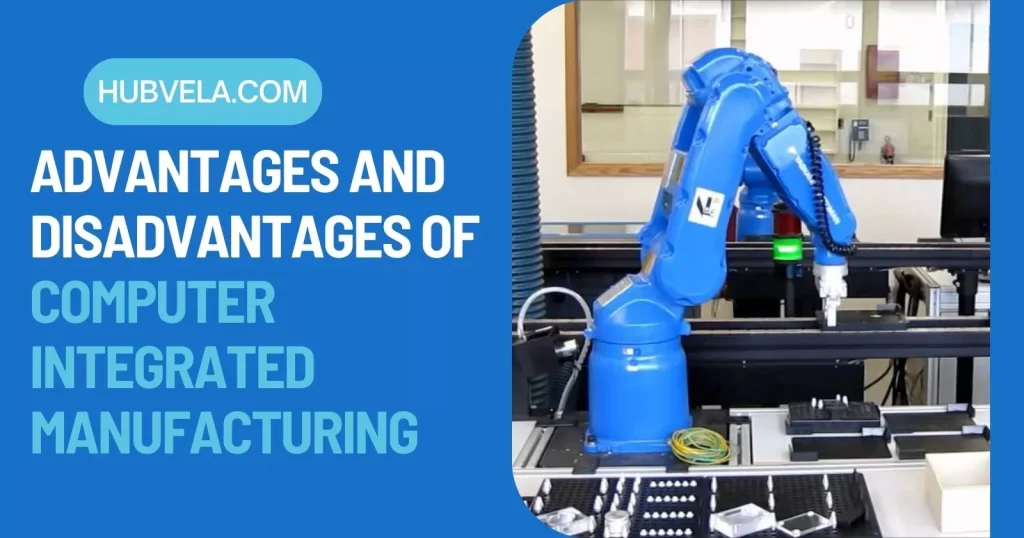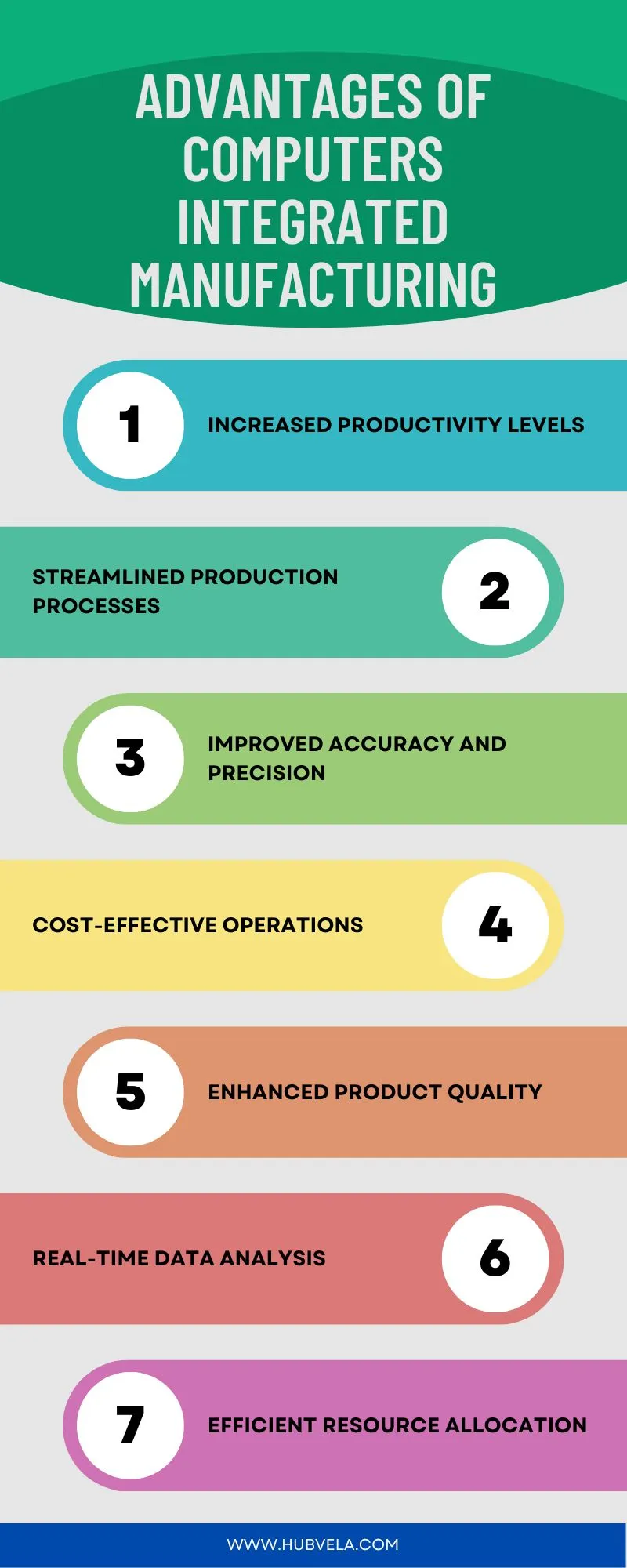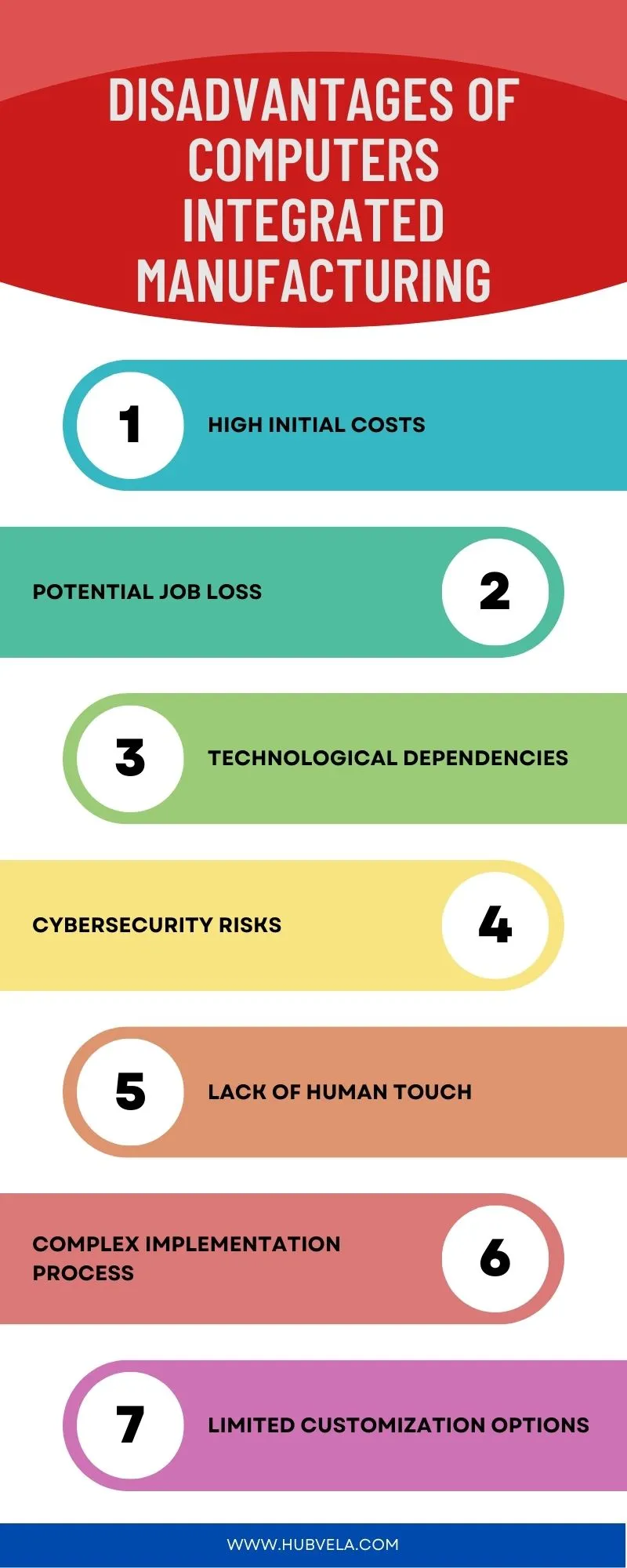Have you ever seen a well-oiled machine in action? Computers integrated manufacturing is like that machine, seamlessly combining technology and production to create a highly efficient system. It has its advantages and disadvantages, and it’s important to understand both sides.
On one hand, computers integrated manufacturing can significantly increase productivity levels, streamline production processes, and improve accuracy and precision. It can also lead to cost-effective operations.
However, on the other hand, this system lacks the human touch, making it impersonal. Implementing it can be complex, and customization options may be limited.
In this article, we will explore the advantages and disadvantages of computers integrated manufacturing, giving you a comprehensive understanding of this technology-driven approach.

--Advertisement--
Advantages of Computers Integrated Manufacturing
Computer-Integrated Manufacturing (CIM) is a manufacturing process that uses computers to integrate various aspects of production, business, and manufacturing, aiming to create more efficient production lines and streamline systems. The integration of computer control into manufacturing has numerous advantages, including:

1. Increased Productivity Levels
With computers integrated manufacturing, you can significantly boost productivity levels by streamlining processes and reducing manual labor. The increased efficiency that comes with automated production allows for faster and more accurate completion of tasks. By eliminating the need for human intervention in repetitive and time-consuming tasks, there’s a reduced chance of errors occurring, leading to a smoother workflow.
With optimized workflow, tasks can be completed in a shorter amount of time, resulting in enhanced output. Computers integrated manufacturing enables the seamless integration of different stages of production, allowing for better coordination and synchronization. This leads to a reduction in downtime and delays, further contributing to increased productivity levels.
2. Streamlined Production Processes
How can computers integrated manufacturing streamline production processes?
By implementing computers integrated manufacturing, you can enjoy several advantages that lead to streamlined production processes.
One of the main benefits is improved efficiency. With the use of advanced technology and automation, tasks can be completed faster, reducing the overall production time.
Additionally, computers integrated manufacturing helps in reducing errors. By automating processes, the chances of human error are significantly reduced, leading to higher accuracy in production.
Moreover, optimized workflows are achieved through computers integrated manufacturing. By analyzing data and identifying bottlenecks, the system can suggest improvements to make operations more efficient.
Lastly, increased automation allows for streamlined operations. Repetitive tasks can be automated, freeing up time for employees to focus on more complex and value-added activities.
3. Improved Accuracy and Precision
Implementing computers integrated manufacturing ensures improved accuracy and precision in your production processes. By automating various tasks, the chances of human error are greatly reduced. Computers can perform tasks with a high level of accuracy, eliminating the possibility of mistakes caused by human intervention.
This improved efficiency leads to streamlined operations, saving time and resources. With reduced errors, you can expect a higher quality output, resulting in satisfied customers and increased competitiveness in the market.
Moreover, computers integrated manufacturing allows for real-time monitoring and analysis, enabling you to identify any potential issues and make adjustments promptly. This level of precision and control over the production processes gives you a competitive advantage in meeting customer demands and maintaining high standards of quality.
4. Cost-Effective Operations
To achieve cost-effective operations through computers integrated manufacturing, you can optimize resource allocation and minimize wastage. By implementing cost saving measures such as automated processes, you can significantly reduce labor costs.
Computers integrated manufacturing allows for optimized production, ensuring that resources are utilized efficiently, leading to reduced material costs. With the automation of tasks, downtime is greatly reduced, resulting in increased productivity and profitability.
Additionally, by streamlining processes through computer integration, you can eliminate unnecessary steps and improve overall efficiency. This not only saves time but also minimizes the risk of errors and rework, further reducing costs.
With computers integrated manufacturing, you can achieve cost-effective operations by harnessing the power of automation and optimizing resource allocation.
5. Enhanced Product Quality
You can achieve enhanced product quality through computers integrated manufacturing by ensuring consistent and precise production processes. Automation benefits play a significant role in improving product quality. With automated systems, tasks are performed with accuracy and precision, reducing errors that can occur in manual processes.
Quality control is also enhanced through the use of computers integrated manufacturing. Automated systems can monitor and measure various parameters during production, ensuring that products meet the required standards and specifications. This reduces the risk of faulty or defective products reaching the market.
Additionally, increased efficiency in production processes leads to improved product quality. By streamlining operations and minimizing human error, computers integrated manufacturing allows for the production of high-quality products in a timely manner.
Ultimately, enhanced product quality contributes to increased customer satisfaction.
6. Real-Time Data Analysis
With computers integrated manufacturing, you can benefit from real-time data analysis, allowing for immediate insights into production processes and enabling proactive decision-making.
Real-time data analysis involves the use of data visualization, predictive analytics, and real-time monitoring to analyze data as it’s generated. This enables you to identify patterns and trends in production data, helping you make data-driven decisions to improve efficiency and quality control.
By monitoring key performance indicators in real-time, you can quickly identify any issues or bottlenecks in the production process and take immediate action to address them. This not only improves productivity but also ensures that quality standards are consistently met.
With real-time data analysis, you have the power to optimize your manufacturing processes and make informed decisions that drive business success.
7. Efficient Resource Allocation
One significant advantage of computers integrated manufacturing is the ability to achieve efficient resource allocation through automated systems. By implementing computer-integrated manufacturing, companies can optimize their resources, ensuring that materials, equipment, and labor are allocated effectively to minimize waste and maximize production efficiency.
Automated systems can monitor and manage inventory levels in real-time, allowing for more accurate inventory management and reducing the risk of overstocking or stockouts. This not only improves production planning but also leads to cost reduction by eliminating the need for excessive inventory storage.
With automated systems, companies can streamline their operations, ensuring that resources are allocated efficiently, resulting in improved productivity and overall performance.
Disadvantages of Computers Integrated Manufacturing
Computer Integrated Manufacturing (CIM) offers various advantages, such as increased efficiency, improved quality, enhanced flexibility, better information management, and increased safety.
However, it also comes with several disadvantages. We will explore some of the main disadvantages of computer integrated manufacturing.

1. High Initial Costs
You may face high initial costs when implementing Computers Integrated Manufacturing. The initial investment required to implement this technology can be substantial. This includes the cost of purchasing and installing the necessary hardware and software, as well as training employees to use the new system effectively. Additionally, there may be ongoing costs for maintenance, upgrades, and technical support. These high initial costs can be a significant barrier for small businesses or those operating on a limited budget.
While there are many advantages to computers integrated manufacturing, such as increased productivity levels, streamlined production processes, and improved accuracy and precision, these benefits come at a price. However, it’s important to weigh these costs against the potential long-term benefits that computers integrated manufacturing can bring to your organization.
2. Potential Job Loss
Implementing Computers Integrated Manufacturing can lead to the potential loss of jobs within an organization. Job displacement is a significant concern when it comes to the adoption of this manufacturing approach. As tasks that were previously performed by humans are automated, there’s a risk of unemployment for those whose roles become redundant. This has economic implications, as job loss can lead to financial instability for individuals and their families.
Additionally, there may be a social impact, as communities that rely heavily on manufacturing jobs may suffer. To mitigate these challenges, retraining programs can be implemented to help affected employees acquire new skills and transition to different roles within the organization or in other industries.
Ethical considerations also arise, as organizations must balance the benefits of automation with the potential negative consequences for their workforce.
3. Technological Dependencies
One major disadvantage of Computers Integrated Manufacturing is the potential for technological dependencies. As technology continues to advance, manufacturing processes become more automated and reliant on computer systems. While this can increase manufacturing efficiency and streamline production, it also creates a dependency on technology.
If there’s a malfunction or failure in the computer system, it can bring the entire manufacturing process to a halt. This can result in significant downtime and loss of productivity.
Additionally, the management of large amounts of data in a computer-integrated manufacturing system can be challenging. Companies must invest in robust data management systems and ensure that their workforce is trained to effectively utilize these systems. This can have workforce implications, as employees may need to acquire new skills or adapt to changing roles within the manufacturing process.
4. Cybersecurity Risks
To address the disadvantages of Computers Integrated Manufacturing, it’s crucial to acknowledge the cybersecurity risks associated with this technological integration.
With the increasing reliance on interconnected systems, cybersecurity measures are of utmost importance to protect sensitive data and prevent potential breaches. Network vulnerabilities pose a significant risk, as they can be exploited by hackers to gain unauthorized access to the system.
Malware attacks are another concern, as they can compromise the integrity of the manufacturing process and lead to disruptions.
Data breaches are a major threat, with the potential for sensitive information to be accessed, stolen, or manipulated. Therefore, comprehensive data protection measures must be implemented, including encryption, access controls, and regular system audits, to mitigate these cybersecurity risks and ensure the security of Computers Integrated Manufacturing systems.
5. Lack of Human Touch
A major disadvantage of Computers Integrated Manufacturing is the lack of human touch, which can result in reduced creativity and innovation in the manufacturing process. With the automation of tasks, there’s a sense of emotional detachment, as machines take over the roles previously performed by humans.
The lack of personal interaction between workers and machines can lead to decreased job satisfaction, as employees may feel disconnected from their work. Additionally, there’s a potential loss of craftsmanship, as manual skills and expertise become less relevant in a computer-driven manufacturing environment.
This can have a negative impact on product quality and aesthetics, as the human touch is often associated with attention to detail and unique design elements. Overall, while Computers Integrated Manufacturing offers many advantages, it’s important to acknowledge and address the limitations of the technology to ensure a balanced approach to manufacturing.
6. Complex Implementation Process
Implementing Computers Integrated Manufacturing can be a complex process that requires careful planning and coordination. There are several implementation challenges that need to be addressed.
Firstly, training requirements can be extensive, as employees need to learn how to operate the new integrated system and understand its functionalities.
System integration can also pose challenges, as existing systems may need to be integrated with the new technology. This process often requires customization and can be time-consuming.
Another disadvantage is the maintenance complexity associated with Computers Integrated Manufacturing. Regular maintenance and troubleshooting are necessary to ensure smooth operation of the system.
Lastly, there’s a learning curve for employees as they adapt to the new technology and processes.
7. Limited Customization Options
You may find that Computers Integrated Manufacturing has limited customization options. One of the main disadvantages of this manufacturing approach is the customization limitations it imposes.
With standardized production and mass production techniques, there’s reduced flexibility in tailoring products to individual customer preferences. The emphasis on efficiency and cost-effectiveness often leads to product uniformity, where variations and unique requests aren’t easily accommodated. This can be problematic for businesses that rely on offering customized products or services as a competitive advantage.
Customers who seek personalized options may be dissatisfied with the limited choices available. While Computers Integrated Manufacturing offers many benefits, it’s important to consider the trade-off between efficiency and customization when deciding whether this approach is suitable for your business.
Conclusion on Advantages and Disadvantages of Computers Integrated Manufacturing
In conclusion, Computers Integrated Manufacturing (CIM) offers numerous benefits and drawbacks. On the positive side, CIM improves productivity by automating processes, reducing human error, and increasing efficiency.
It also allows for real-time monitoring and data analysis, enabling better decision-making and resource optimization. CIM enhances communication and collaboration among departments, leading to improved coordination and streamlined workflows.
However, there are also disadvantages to consider. CIM requires significant upfront investment and ongoing maintenance costs.
It may lead to job losses as automation replaces certain tasks. Additionally, there are security and privacy concerns associated with storing sensitive data in computer systems.
It’s important for companies to carefully weigh these advantages and disadvantages before implementing CIM to ensure it aligns with their specific needs and goals.


